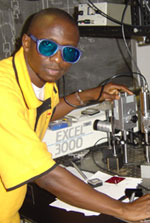Laboratory Facilities
- A CPA-Series Ti:Sapphire system from Clark-MXR, which pumps a TOPAS system from Light Conversion. We currently have it set up as a 1 ps system that provides tunable output at 1 kHz from the UV to the far IR.
- An Ekspla System consisting
of a picosecond Nd:YAG laser that can emit 80 mJ, 30 ps pulses, and is doubled and tripled in frequency. Its ultraviolet output pumps an optical parametric generator/amplifier system that ultimately delivers 20 picosecond optical
pulses with a wavelength that can be tuned from 420 nm to 2 micrometer in the infrared.
- Degenerate Four Wave Mixing in the phase conjugated configuration and transient grating pump and probe experiments over a time interval of 10 ns and a time resolution of 20 ps.
- Degenerate Four Wave Mixing in the forward boxcar configuration and transient grating pump and probe experiments over a time interval of 1 ns and a time resolution of 1 ps.
- Noncollinear Third-order Maker Fringes for the measurement of electronic third-order nonlinear optical susceptibilities.
- Second-order Maker Fringes for the measurement of second-order nonlinear optical susceptibilities.
- Transient photoconductivity.
- Vapor transport growth of organic molecular crystals
- A high vacuum organic molecular beam deposition system to grow organic thin films.
- Various ancillary equipment, such as oscilloscopes, gated
integrators, photomultipliers, pyroelectric detectors, InGaAs cameras, Silicon and InGaAs picojoule-meters, optical delay lines, fiber coupling systems, ...
Shared facilities in the Physics Laser Spectroscopy Laboratory
- Up and Down Olympus microscope with several input and output ports that can be used for laser-based nonlinear optical and multiphoton microscopy.
- A Pharos femtosecond laser that delivers 150 fs pulse trains with a repetition rate tunable between 10 kHz and 200 kHz, and a PicoQuant time-correlated single photon counting system for the measurement of photoluminescence transients.
- Up and Down olympus microscope with various inputs for laser illumination.
- Several other laser sources, spectrometers, microscopes, and detectors, including a streak camera working at 1.5 micrometers and the femtosecond/picosecond laser source from Clark MXR mentioned above.
Other facilities

![Ekspla [Image: Ekspla]](stor/laser_and_opg.jpg)
![TOPAS [Image: TOPAS]](stor/topas.jpg)
![DFWM scheme [Image: DFWM scheme]](stor/DFWM.jpg)
![DFWM experiment [Image: DFWM experiment]](stor/fDFWM.jpg)
![Multi-wave mixing [Image: Multi-wave mixing]](stor/nonlineartree.jpg)